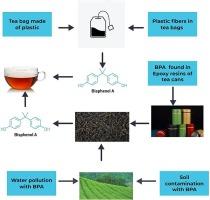鉴定茶叶样品中双酚 A 的常用和新型方法:系统回顾研究
IF 4.9
2区 化学
Q1 CHEMISTRY, ANALYTICAL
引用次数: 0
摘要
茶是世界上消费量最大的饮料,因此其安全性尤为重要。双酚 A(BPA)是一种已在环境中发现的污染物。本系统研究的重点是茶叶中的双酚 A 含量。在没有时间限制的情况下,使用相关关键词在数据库中进行了搜索。在大多数研究中,茶叶样本中都检测到了双酚 A。茶叶样本中双酚 A 的含量范围在 ND(未检出)和 219 纳克/克之间。约有 28% 的研究报告了双酚 ND 水平。本手稿还讨论了测量茶叶中双酚的传统技术和新技术。常用的方法有固相萃取法(SPE)和QuEChERS(快速、简便、廉价、有效、坚固和安全)法。然而,包括使用共价有机框架和纳米颗粒在内的新型方法也是一项杰出的研究。本文章由计算机程序翻译,如有差异,请以英文原文为准。

Common and novel methods for the identification of bisphenol A in tea samples: A systematic review study
Tea is the most widely consumed beverage in the world, so its safety is of particular importance. Bisphenol A (BPA) is a pollutant that has been identified in the environment. This systematic study was conducted with the focus on the amount of BPA in tea. Searching in databases was done with related keywords without limitation in time. In most studies, bisphenol A has been detected in tea samples. The range of bisphenol A in tea samples is between ND (not detected) and 219 ng/g. In about 28 % of the studies, the level of bisphenol ND has been reported. Conventional and new techniques for measuring bisphenol in tea are also discussed in this manuscript. The common methods are the use of SPE (Solid-Phase Extraction) and QuEChERS (Quick, Easy, Cheap, Effective, Rugged and Safe) method. However, novel methods, including the use of covalent organic frameworks and Nano particles, are outstanding researches.
求助全文
通过发布文献求助,成功后即可免费获取论文全文。
去求助
来源期刊

Microchemical Journal
化学-分析化学
CiteScore
8.70
自引率
8.30%
发文量
1131
审稿时长
1.9 months
期刊介绍:
The Microchemical Journal is a peer reviewed journal devoted to all aspects and phases of analytical chemistry and chemical analysis. The Microchemical Journal publishes articles which are at the forefront of modern analytical chemistry and cover innovations in the techniques to the finest possible limits. This includes fundamental aspects, instrumentation, new developments, innovative and novel methods and applications including environmental and clinical field.
Traditional classical analytical methods such as spectrophotometry and titrimetry as well as established instrumentation methods such as flame and graphite furnace atomic absorption spectrometry, gas chromatography, and modified glassy or carbon electrode electrochemical methods will be considered, provided they show significant improvements and novelty compared to the established methods.
 求助内容:
求助内容: 应助结果提醒方式:
应助结果提醒方式:


